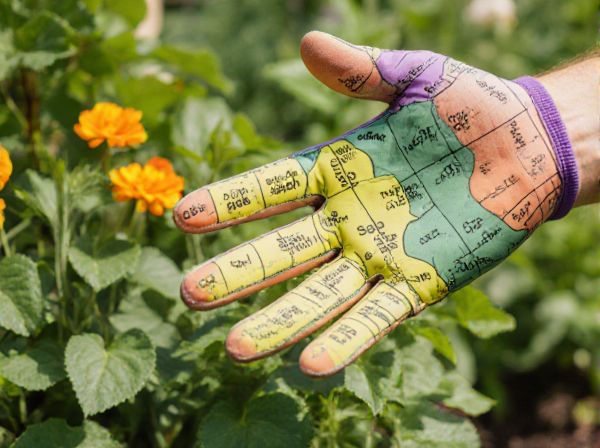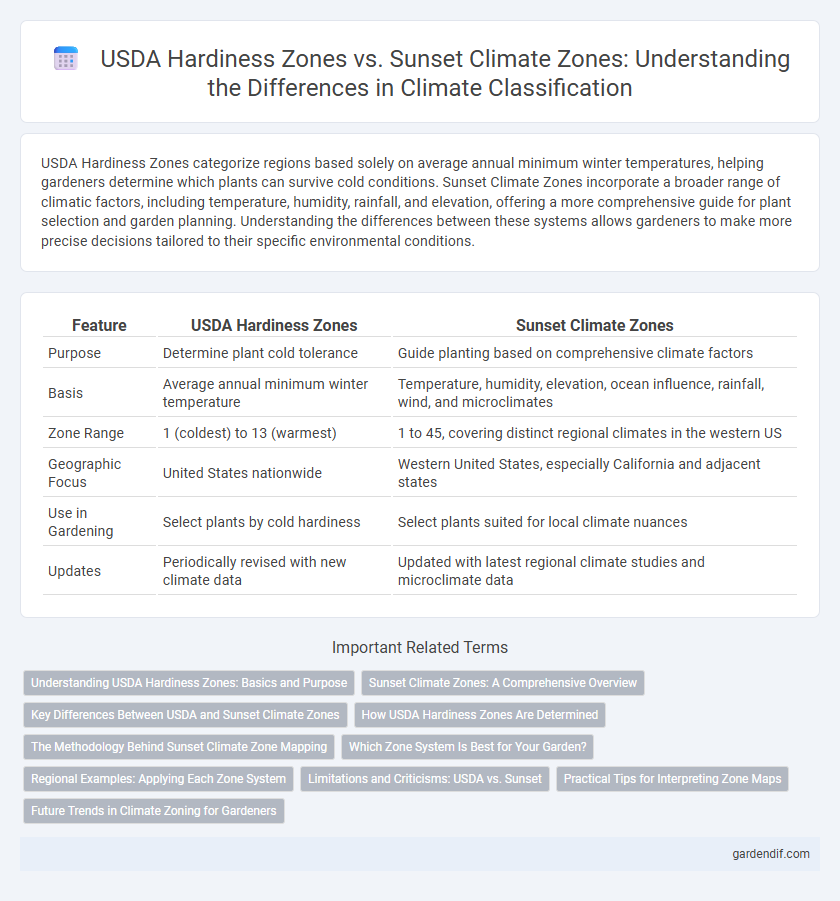
USDA Hardiness Zones vs Sunset Climate Zones Illustration
USDA Hardiness Zones categorize regions based solely on average annual minimum winter temperatures, helping gardeners determine which plants can survive cold conditions. Sunset Climate Zones incorporate a broader range of climatic factors, including temperature, humidity, rainfall, and elevation, offering a more comprehensive guide for plant selection and garden planning. Understanding the differences between these systems allows gardeners to make more precise decisions tailored to their specific environmental conditions.
Table of Comparison
| Feature | USDA Hardiness Zones | Sunset Climate Zones |
|---|---|---|
| Purpose | Determine plant cold tolerance | Guide planting based on comprehensive climate factors |
| Basis | Average annual minimum winter temperature | Temperature, humidity, elevation, ocean influence, rainfall, wind, and microclimates |
| Zone Range | 1 (coldest) to 13 (warmest) | 1 to 45, covering distinct regional climates in the western US |
| Geographic Focus | United States nationwide | Western United States, especially California and adjacent states |
| Use in Gardening | Select plants by cold hardiness | Select plants suited for local climate nuances |
| Updates | Periodically revised with new climate data | Updated with latest regional climate studies and microclimate data |
Understanding USDA Hardiness Zones: Basics and Purpose
USDA Hardiness Zones classify regions based on average annual minimum winter temperatures, guiding plant selection for cold tolerance. These zones are essential for determining which plants can survive in specific climates, primarily focusing on temperature extremes rather than overall growing conditions. They differ from Sunset Climate Zones, which incorporate factors like humidity, wind, and elevation to provide a more comprehensive understanding of a region's gardening environment.
Sunset Climate Zones: A Comprehensive Overview
Sunset Climate Zones provide a detailed classification system based on microclimates, accounting for factors such as temperature, humidity, wind patterns, and elevation, offering more precise guidance for regional gardening and landscaping than USDA Hardiness Zones. Unlike USDA zones that primarily focus on minimum winter temperatures, Sunset zones reflect a broader range of climate variables, making them particularly valuable for selecting plants suited to specific environmental conditions. This nuanced approach enables gardeners and agricultural planners to optimize plant health, productivity, and sustainability across diverse ecological zones.
Key Differences Between USDA and Sunset Climate Zones
USDA Hardiness Zones classify regions based on average annual minimum winter temperatures, primarily aiding gardeners in selecting plants that survive cold weather. Sunset Climate Zones integrate factors like temperature fluctuations, elevation, microclimates, and humidity, offering a more detailed guide for plant suitability across diverse environments, especially in the western United States. The key difference lies in USDA's temperature-only metric versus Sunset's multifaceted approach, providing gardeners with a nuanced understanding of climate-specific growing conditions.
How USDA Hardiness Zones Are Determined
USDA Hardiness Zones are determined based on the average annual minimum winter temperature, divided into 10-degree Fahrenheit zones that guide planting decisions. These zones provide critical data for assessing plant cold tolerance by categorizing regions from Zone 1 (coldest) to Zone 13 (warmest). Unlike Sunset Climate Zones, which consider multiple climate factors like temperature, humidity, and terrain, USDA zones focus solely on minimum temperature extremes to establish plant hardiness standards.
The Methodology Behind Sunset Climate Zone Mapping
Sunset Climate Zone mapping uses a more complex methodology compared to USDA Hardiness Zones, incorporating factors such as latitude, elevation, ocean influence, and microclimates for precise regional categorization. Unlike USDA zones, which rely primarily on average annual minimum winter temperatures, Sunset zones account for temperature variations throughout the year, soil types, and seasonal wind patterns to provide tailored horticultural guidance. This comprehensive approach enables gardeners and landscapers to select plants with greater accuracy based on real-world climate nuances.
Which Zone System Is Best for Your Garden?
USDA Hardiness Zones categorize regions based on average annual minimum winter temperatures, making them crucial for selecting plants that survive cold climates. Sunset Climate Zones consider a broader range of climatic factors, including temperature variations, precipitation patterns, and soil types, providing more detailed guidance for diverse gardening conditions. Choosing the best zone system depends on your garden's needs: USDA zones offer simplicity for frost-sensitive plants, while Sunset zones deliver comprehensive insights for optimizing plant health in varied environments.
Regional Examples: Applying Each Zone System
USDA Hardiness Zones categorize regions based on average annual minimum winter temperatures, guiding plant selection for cold tolerance, while Sunset Climate Zones consider a broader range of factors, including temperature, precipitation, and elevation, offering a more detailed climate profile for gardening. For example, California's Bay Area falls within USDA Zone 9b but spans multiple Sunset Zones, reflecting its diverse microclimates from coastal fog to inland heat. This differentiation allows gardeners to choose plants better suited to specific conditions, such as drought tolerance in Sunset Zone 14 versus winter hardiness emphasized by USDA zones.
Limitations and Criticisms: USDA vs. Sunset
USDA Hardiness Zones primarily focus on average annual minimum winter temperatures, which limits their ability to account for factors like humidity, soil type, and microclimates, leading to oversimplified climate assessments. Sunset Climate Zones incorporate a broader range of variables, including temperature ranges, elevation, and proximity to oceans, but they face criticism for being overly complex and less universally applicable due to regional specificity. Both systems can mislead gardeners and landscapers by either oversimplifying or complicating climate conditions, which underscores the need for integrated climate data tailored to local environmental nuances.
Practical Tips for Interpreting Zone Maps
USDA Hardiness Zones categorize regions based on average annual minimum winter temperatures, offering gardeners essential guidance for selecting frost-tolerant plants. Sunset Climate Zones incorporate factors like elevation, precipitation, and seasonal temperature variations, providing a more detailed understanding of local growing conditions. When interpreting zone maps, prioritize plant hardiness ratings alongside Sunset's microclimate nuances to optimize garden planning and plant selection.
Future Trends in Climate Zoning for Gardeners
USDA Hardiness Zones primarily measure average annual minimum winter temperatures, while Sunset Climate Zones incorporate a broader range of factors including temperature, rainfall, and seasonal patterns, offering a more nuanced understanding for gardeners. Future trends in climate zoning are moving toward integrating dynamic climate models that account for increasing variability and extreme weather events driven by climate change. This shift enables gardeners to select plant species with greater resilience and adaptability, optimizing garden success amid evolving environmental conditions.
USDA Hardiness Zones vs Sunset Climate Zones Infographic

 gardendif.com
gardendif.com